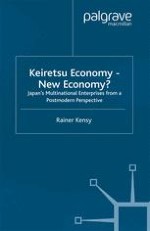2001 | Buch
Über dieses Buch
This book combines a theoretical study of Japan's economic structures and multinational enterprises with a post-modern analysis of the contemporary multinational enterprise. The author considers the appropriateness of the post-modern approach for discussing economic activities, in particular the New Economy, and also Japanese society and culture. Kensy analyses Japan's economic structure, interpreting its methods, strategies and results in a post-modern context and presents a survey of socio-economic development in Japan since the beginning of westernization. He goes on to discuss Japanese models for the transformation of society in the future, with particular reference to the Keiretzu. Finding Japan to be a truly postmodern society, Kensy shows that Japan is prepared to be a leader in the New Economy. Kensy takes an innovative and stimulating approach that will be of interest to those seeking to better understand the development and future of the economic structures of Japan.
Anzeige
